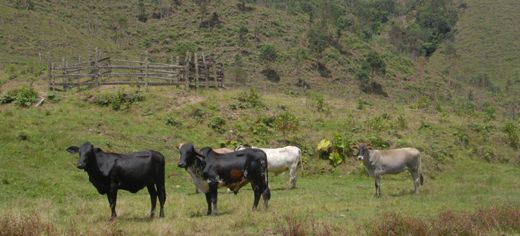
Converting cattle ranches to forests is a cheap way of tackling climate change and saving species threatened with extinction, a new study has found.
Researchers carried out a survey of biodiversity, carbon stocks, and economic activity in one of the world’s most threatened ecosystems, the western Andes of Colombia, where cattle ranching is the dominant type of farming.
They found that farmers could make the same or more money by allowing their land to naturally regenerate.
The alternative would involve paying farmers to change the use of their land from raising cows to “growing” carbon – receiving around $1.99 per tonne of carbon dioxide that the trees they grow remove from the atmosphere.
Felicity Edwards, a PhD student in the University of Leeds’ Faculty of Biological Sciences, who took part in the study, said: “Forest regeneration in the Andes provides a fantastic opportunity to benefit biodiversity and provide carbon stocks simultaneously. Investment is often required to maintain pasture land. By creating a carbon market, farmers could benefit financially while letting land return to its natural state.”
The study, published in the journal Nature Climate Change, found that letting forests regenerate also had a major impact on the populations of threatened species.
Of 40 bird species that are threatened with extinction in the region, 33 were found in secondary forests. In cattle pastures, by contrast, only 11 species could be found.
Lead researcher Dr James Gilroy from the University of East Anglia’s school of Environmental Sciences carried out the research while at the Norwegian University of Life Sciences. He said: “This research shows that there are great environmental and ecological benefits to changing land use from cattle farming to forest, and there may even be financial benefits too.
“If these areas were instead allowed to regenerate to forest, then significant amounts of carbon dioxide would be captured from the atmosphere. Biodiversity would also be restored, improving habitats for many species at risk of extinction – all at minimal cost. It’s a win-win situation.”
“This costs very little money,” said senior scientist, Dr David Edwards, of the University of Sheffield’s Department of Animal and Plant Sciences.
“Providing people are willing to spend the money, this could be a critical mechanism for stopping climate change and protecting some of the world’s most endangered species.
“The economic benefits of cattle farming are minimal, so this is a way farmers could make the same, if not more money. The land would be rented off farmers for 30 years and they would be paid for the carbon grown.
“We studied older forests that are around 20-30 years old and found they had recovered around half of the carbon of a really mature forest. More carbon comes back every single year, and as it does so, large numbers of highly threatened species return.
“The impact on reducing the biodiversity extinction crisis and climate change could be huge.”
The research team included academics at the University of Leeds, University of East Anglia, Bangor University, University of Sheffield, University College London, the Norwegian University of Life Sciences, The Alexander von Humboldt Biological Resources Research Institute in Colombia, and James Cook University in Cairns, Australia.
Further information
Contact: Chris Bunting, Press Officer, University of Leeds; phone; 0113 343 2049 or email c.j.bunting@leeds.ac.uk.